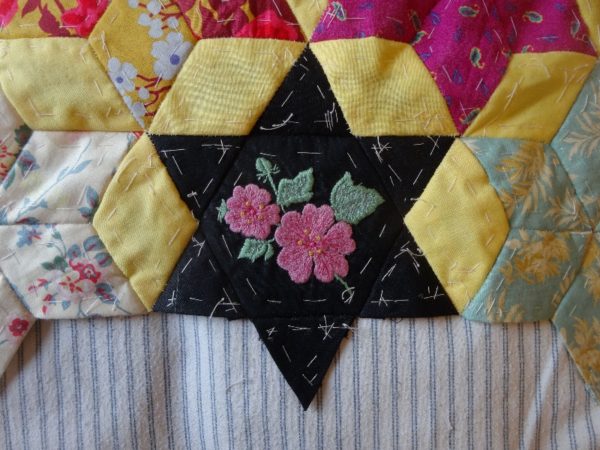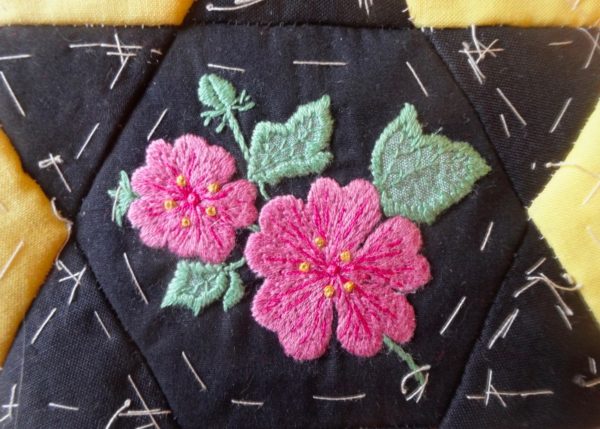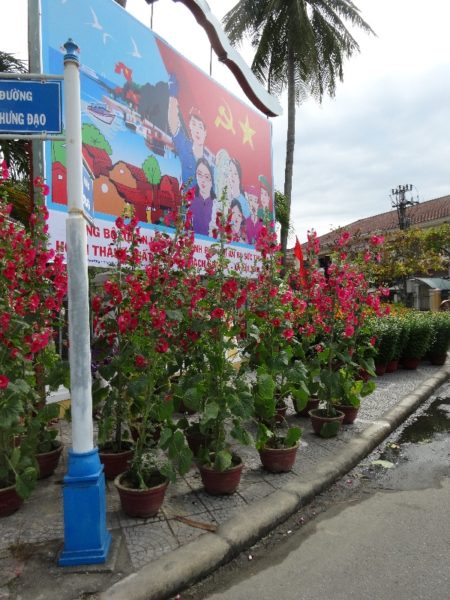
Ipsden altar frontal: the mallow (hand embroidered by Mary Addison)
This week I’ve been pushing multitasking to the limit (well, for me, anyway) and brain pathways are getting just as tangled as the threads from the two different jerseys I’m knitting and the monogrammed cushion I’m embroidering. Mornings, while the young master is at nursery are taken up with embroidery (light so much better) and working out Fair Isle designs for the bottom of a new jumper for the small person (ditto the bit about light and add to it the benefits of a clear morning head). During the day, I’ve managed to get on with a bit of straightforward knitting for a little long sleeved woollen polo shirt while overseeing Duplo construction, but in general this becomes evening work – remarkably untaxing and delightfully soothing. I never got into knitting while my own children were little and it’s only now that I realise what I missed. After a day of mixed success with the potty training, it’s extraordinary how advancing a few inches of knitting can end the day on a high!

Ipsden altar frontal: the mallow (hand embroidered by Mary Addison)
But with lots of projects on the go, I’m glad that I still have a few embroidered flowers for the altar frontal to show and once again this one is a flower that reminds me of the Oxfordshire countryside we left last summer – a time when the mallow was at its most prolific, deep pink flowers and a bushy straggle of haphazard leaves lining every dusty lane, well trodden footpath and patch of waste ground. So much about its untidy bearing suggests ‘weed’ yet its flowers are as pretty and profuse as any a garden grown lavatera. (And on this I’m confused. The lavatera, Lavatera olbia, is also known as the tree mallow, yet the mallow’s Latin name is Malva sylvestris; both have very similar flowers and colouring, yet seemingly no consanguinity – convergent evolution? . More research needed!). The mallow is instead closely related to the splendid statuesque hollyhock and the exotic hibiscus, whose flowers are indeed alike but quite different from the mallow! Interestingly, the mallow is also related to the cotton plant, but I can make no comment on this as cotton isn’t grown in England.

Hollyhocks (closely related to mallow) seen on a street corner in Hoi An, Vietnam to celebrate Vietnamese new year
Though regarded as a weed now, in the past mallow was valued as both food and medicine. Pliny recommended a daily dose of mallow sap diluted in water to ward away aches and pains, while Cicero thought eating young mallow shoots gave him indigestion. Martial found it a useful hangover cure for the morning after an orgy. Some folk remedies suggest application of the leaves to draw out insect stings or a paste of its gummy sap as a poultice for skin infections. The fruit, a round of seeds looking like a cottage loaf sliced into segments, is known as ‘cheese’, has a indistinct, slightly nutty taste, was often picked and nibbled by children and gave rise to the plant’s folk names, like ‘cheese flower’, ‘pick-cheeses’ (Norfolk), ‘Billy buttons’ or ‘pancake plant’. So far have we as a nation moved from our rural roots, that I’m not sure any children today, in this modern risk averse world would dream of putting one of these little ‘cheeses’ into their mouths.

6 Comments
Interesting post about mallow. We live on the coast of California and mallow is everywhere growing into big bushes especially when it’s a rainy year. It responds well to pruning and is easy to grow. So glad you are posting again!
Good to hear from you Ann and thank you for being so kind as to comment.
I’m glad you too can enjoy mallow and it’s interesting to know how well it grows in California with its Mediterranean climate.
Here in Nova Scotia people do grow the mallow in their formal beds. Years ago I dug up some escapees, they look nice, bloom a long time and are highly aggressive. Just what I need around my pond. They even put up a good fight with the brambles.
I am also delighted you are posting again – you are an inspiration.
Fascinating to know that mallow likes California and Nova Scotia in equal measure!
Thank you for leaving such a lovely comment.
The children may put it in their mouths, but their parents would be horrified, whereas a couple of generations ago, their parents would probably have joined in!
True, Rachel – the parents would be dashing them from their lips in utter horror!